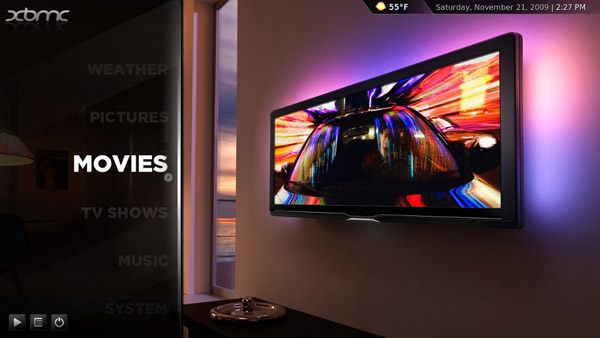 If you’re like me you probably long-ago did away with the bland programming of CCTV9, the endless carousel of period dramas, and ever-more-annoying variety shows that China’s cable providers offer up. For some that means getting outside and getting a life. For people like me, that means finding better ways to get the entertainment I want when I want it.
If you’re like me you probably long-ago did away with the bland programming of CCTV9, the endless carousel of period dramas, and ever-more-annoying variety shows that China’s cable providers offer up. For some that means getting outside and getting a life. For people like me, that means finding better ways to get the entertainment I want when I want it.
This is part one of a three-part series I’ve wanted to put together for a while now outlining how to get better sources of entertainment while living in China. It intends to walk you through hooking up your computer to your TV, installing some media centre (HTPC) software, dishing out what my current HTPC setup is (so you may want to wait and read that before you rush out and buy any of the gear mentioned below), and finding some good sources of media.
Step 1 – Basic Hookup of a Computer to a TV
How you hookup your computer to your TV depends entirely on what type of computer and what type of TV you have. The absolute easiest is if you have a nice new flatscreen TV with HDMI inputs and a computer with HDMI outputs. For the cost of new laptops and flatscreen TVs, I’m betting a fair number of expats are graced with such techno-treasures. However, if you’re stuck with an old laptop or TV that pre-dates the Internet, don’t fret, there’s solutions for you too.
First, determine what outputs your computer has. It should have one of the following:

- HDMI: Some newer laptops have an HDMI port on it. If you have this and you have a new HD TV, life is easy for you.
- DVI: Most newish computers use this VGA replacement port to connect to a monitor. Some TVs also have this as an input.
- Mini DisplayPort: Usually found on MacBooks and MacBook Pros — but not exclusive to Apple.
- Mini-DVI: Replaced by the Mini DisplayPort, still found on older Apple computers.
- VGA: This port has been on the back of computers since monitors weighed the same as a 10-year-olds.
- S-Video: Nearly as old as VGA, and offering similar analog quality.
There are others, but those are the most common.
Next, check out the hard-to-reach areas of your TV for what inputs it has. It will likely be (in order of preference for quality):

- HDMI: As above, this is the best. If you can go full HDMI from PC to TV you’re golden.
- DVI: Also as above, and pretty darn good. Though DVI doesn’t carry an audio signal, so check the note below about that.
- Component: Despite usually being analog, this Green/Blue/Red collection of inputs can still handle some hefty resolutions (up to 1080i).
- Composite: Often found with his red and white audiophile buddies, this yellow guy has been a mainstay in video signal transfer since the Reform and Opening. Quality to match.
Audio:
None of the computer outputs mentioned above (with the exception of HDMI) carry an audio signal. Fortunately audio I/O is pretty simple. Simply connect an 1/8″ phono line (the size of most headphones) to your audio out/headphones jack on your computer and connect the other end to your TV. If your TV doesn’t have an 1/8″ phono line in, grab yourself a cable or adapter like one of these.
Analog (VGA/S-Video) Signals:
Analog signals from a PC don’t usually line up very well for displaying on a TV. If you are using an analog output from your computer, you’re going to need to grab yourself a little converter box like one of these. Until recently I used a VT-280 box and it worked decent enough.
Quality:
The quality of the input can only be as good as the quality of the output. So, if you output from your computer with a VGA cable, but then use an adapter to get it to fit into the HDMI or DVI slot on your TV, it will still be a VGA signal and VGA quality.
Mac Users:
You’re going to need an adapter (there are cheaper knock-offs on Taobao – just search for the one you need).
Step 2 – Media Centre Software and Remote Controls
The novelty of seeing your computer’s desktop on your TV will wear thin pretty quickly, so next up we’ll need to get some decent software on there to make your new media centre looking fancy.
There are a number of different software packages out there, but my absolute favourite is XBMC. Standing for XBox Media Center, the software was originally a hack for XBox users to turn their gaming console into a media center, and has since greatly expanded in its form and function. Here’s how the xbmc.org site describes it:
XBMC is an award-winning free and open source (GPL) software media player and entertainment hub for digital media. XBMC is available for Linux, OSX, and Windows. Created in 2003 by a group of like minded programmers, XBMC is a non-profit project run and developed by volunteers located around the world. More than 50 software developers have contributed to XBMC, and 100-plus translators have worked to expand its reach, making it available in more than 30 languages.

While XBMC functions very well as a standard media player application for your computer, it has been designed to be the perfect companion for your HTPC. Supporting an almost endless range of remote controls, and combined with its beautiful interface and powerful skinning engine, XBMC feels very natural to use from the couch and is the ideal solution for your home theater.
Currently XBMC can be used to play almost all popular audio and video formats around. It was designed for network playback, so you can stream your multimedia from anywhere in the house or directly from the internet using practically any protocol available. Use your media as-is: XBMC can play CDs and DVDs directly from the disk or image file, almost all popular archive formats from your hard drive, and even files inside ZIP and RAR archives. It will even scan all of your media and automatically create a personalized library complete with box covers, descriptions, and fanart. There are playlist and slideshow functions, a weather forecast feature and many audio visualizations. Once installed, your computer will become a fully functional multimedia jukebox.
There are versions for all major operating systems. It works like any other application on your computer — simply download, install and run.
Remotes and Mobile Apps
There are a variety of remotes that will work with XBMC — many of which you’re likely to be able to find on Taobao or at your local electronic city. If you can’t be bothered cluttering your coffee table with another remote and you have an iOS or Android device, check out the xbmc iOS app and Android app. Myself, I use Plexures, a free iPhone/iPod Touch/iPad app, which works completely via gestures without buttons.








Nice! I’ve been wanting to do this for so long. I think I’m just going to jump straight to an Apple TV-like solution, though.
Is the Apple TV going to make an appearance next post? Do you use Apple TV and XBMC together?
Haha, it certainly does and I certainly do. Check out part II for all the details.
I highly recommend it.
Pingback: How-to: Setup an HTPC for better TV in China (Part II – My Gear) | Lost Laowai China Blog
Pingback: How-to: Setup an HTPC for better TV in China (Part III – Media Sources) | Lost Laowai China Blog